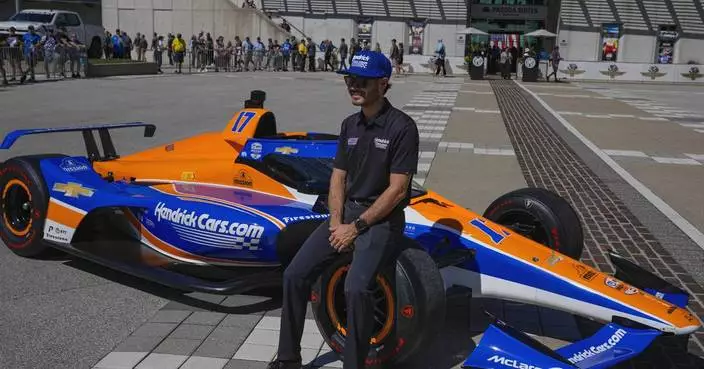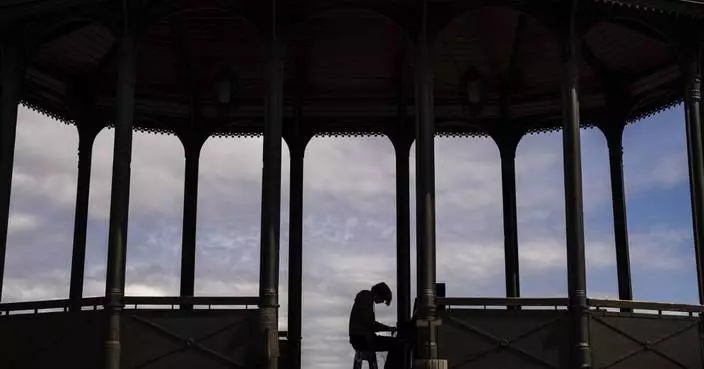Chris Gagin says he hasn't changed much politically, even as so much around him has.
The attorney from rural Belmont County, Ohio, became a Republican in 2013 after Democrats embraced environmental policies that he believed were detrimental to the area's coal mining and fracking industries. As an anti-abortion-rights, pro-gun conservative, he felt unwelcome.
"Conservative Democrats have become all but extinct," said Gagin, who served for a time as county Republican chairman. He's among many former Democrats in blue-collar Ohio who voted for Donald Trump in 2016 and for an all-GOP statewide ticket last year. Those ballots helped turn large swaths of territory along the Ohio River — places that supported Democrats Bill Clinton and Barack Obama — from blue to bright red.

FILE - In this Oct. 10, 1996, file photo President Bill Clinton waves as he prepares to address the crowd during a campaign rally at the Old Montgomery County Courthouse in Dayton, Ohio. As Democrats bring their primary debate to Ohio Tuesday, the question is whether the Republican foothold in Appalachia and places like industrial Youngstown is irreversible, whether Ohio is a political battleground no more. (AP PhotoGreg Gibson, File)
As Democrats bring their next primary debate to Ohio on Tuesday, they're grappling with whether the new Republican dominance in those industrial and rural pockets has pushed Ohio out of their reach.
Some Democratic presidential campaigns are contemplating once unheard-of White House victory scenarios that leave out Ohio. The storied swing state — a place that sided with the winning presidential candidate in all but one election since 1944 — seems likely to be eclipsed by Wisconsin, Michigan and Pennsylvania in next year's election.
"Ohio isn't at the center of the political universe as it used to be," said Kyle Kondik, an elections analyst at the University of Virginia Center for Politics.

FILE - In this Tuesday, July 25, 2017 file photo a supporter holds up a sign as President Donald Trump speaks at the Covelli Centre in Youngstown, Ohio. As Democrats bring their primary debate to Ohio Tuesday, the question is whether the Republican foothold in Appalachia and places like industrial Youngstown is irreversible, whether Ohio is a political battleground no more. (AP PhotoTony Dejak, File)
At this same time during the last presidential campaign, in October 2015, presidential campaigning in Ohio was so vigorous there were fears it was drowning out that year's elections. A group concerned about one of that year's ballot issues, the American Policy Roundtable, even bought an online ad reminding voters the presidential election was still a year away. The run-up to the 2020 election has been quieter, with Ohio seeing only a handful of notable campaign events since spring.
Trump won Ohio in 2016 by 8 percentage points — a larger margin than any winner since George H.W. Bush in 1988. While Democrats surged in many other swing states in 2018, they lost every statewide race in Ohio but one.
Democratic presidential candidates will debate Tuesday in Westerville, a suburb outside Columbus replete with the college-educated women and young voters who Democrats see as representing the party's best prospects of an Ohio comeback, along with minorities.

FILE - In this Tuesday, July 25, 2017 file photo President Donald Trump speaks at a rally at the Covelli Centre in Youngstown, Ohio As Democrats bring their primary debate to Ohio Tuesday, the question is whether the Republican foothold in Appalachia and places like industrial Youngstown is irreversible, whether Ohio is a political battleground no more. (AP PhotoCarolyn Kaster, File)
"I think it's totally winnable," said Democratic political consultant Aaron Pickrell, an Ohio campaign director and adviser to Obama's successful 2008 and 2012 campaigns. Any victory will depend on finding the right balance of supporters in urban, suburban, rural and former industrial communities, he said.
Ohio was long a bellwether because its population resembled that of the United States as a whole. It hasn't picked a losing presidential candidate since voting for Richard Nixon in 1960. But the state no longer mirrors the nation.
It's whiter and slightly older than the national average. Just 29% of Ohio residents have a college degree, compared with the national average of nearly 32.6%. That education gap has translated into lower earnings. The state's median household income is $56,111, nearly $6,000 below the national median.

FILE - In this Aug. 25, 1996, file photo President Bill Clinton pulls the rope to blow the whistle from the rear of the train during a stop on his 21st Century Express Tour in Chillicothe, Ohio. As Democrats bring their primary debate to Ohio Tuesday, the question is whether the Republican foothold in Appalachia and places like industrial Youngstown is irreversible, whether Ohio is a political battleground no more. (AP PhotoGreg Gibson, FILE)
Republicans run stronger with those groups. The GOP tilt is even more pronounced in places like Belmont County, which sits on the state line with Pennsylvania and West Virginia.
Gagin said voters there are looking for politicians who channel their frustration. Trump took more than two-thirds of the county's vote in 2016. In 2008, Republican John McCain lost narrowly to Obama.
"Not to get racial about it, but lots of white folks feel others are either getting ahead or getting a handout, while they're just having to go to work every day and just falling further and further behind," Gagin said. "That's how you get to the politics of aggrievement."

FILE - In this Tuesday, July 25, 2017 file photo President Donald Trump pauses as he speaks during a rally, Tuesday, July 25, 2017, at the Covelli Centre in Youngstown, Ohio. As Democrats bring their primary debate to Ohio Tuesday, the question is whether the Republican foothold in Appalachia and places like industrial Youngstown is irreversible, whether Ohio is a political battleground no more. (AP PhotoCarolyn Kaster, File)
Republican consultant Karl Rove, who engineered President George W. Bush's two wins in Ohio, said the numbers don't tell the whole story.
"I'm not one of these people who believes demographics is necessarily destiny, so I do think it has to do with things other than that it's a blue-collar, white state," he said. "Maybe it has to do with the quality of the arguments being made rather than simple demographics."
In a twist, one sign of hope for Democrats might be the type of Republicans Ohio elects to state office.

FILE - In this Aug. 27, 1996 file photo President Bill Clinton greets supporters at a campaign stop in Wyandotte, Ohio. As Democrats bring their primary debate to Ohio Tuesday, the question is whether the Republican foothold in Appalachia and places like industrial Youngstown is irreversible, whether Ohio is a political battleground no more. (AP PhotoDoug Mills, File)
The state's last two Republican governors — John Kasich and now Mike DeWine — are politically pragmatic politicians who have embraced bipartisan ideas, including on health care and guns. Kasich is a vocal Trump detractor and DeWine walked a careful line with the president, appearing with him only at the finale of the 2018 campaign.
Democrats also point to consistent statewide victories by Sen. Sherrod Brown, one of his chamber's most liberal members and the sole Democrat to win statewide last year. The party looks to Brown's straight-talking, dignity-of-work message as a model for regaining traction in blue-collar areas.
"Ohio is in play," said Gerald Austin, a Cleveland-based Democratic strategist. "The No. 1 way to beat an incumbent is on the incumbent's record. Did Donald Trump bring back coal jobs? Have more steel plants opened up here? Did something happen on that infrastructure bill he was going to get done that I'm not aware of? You remind voters of what they said and what they haven't done."

FILE - In this Feb. 23, 2008, file photo supporters cheer as Democratic presidential hopeful, Sen. Hillary Clinton, D-N.Y., makes a campaign stop at Cincinnati State Technical and Community College Gymnasium in Cincinnati. As Democrats bring their primary debate to Ohio Tuesday, the question is whether the Republican foothold in Appalachia and places like industrial Youngstown is irreversible, whether Ohio is a political battleground no more. (AP PhotoCarolyn Kaster, File)
Pickrell said Democrats can win those disenfranchised voters by focusing on health care and the economy. He also argued that views on environmental policy may be shifting and climate change is no longer a fringe issue.
"Now people understand the need and utility of solar panels," he said. "They understand the utility of an electric car. They understand algae blooms in Lake Erie." Pickrell added: "I don't think it's as polarizing as it once was. And in a lot of areas, it's probably swinging people our way."
Mandi Merritt, a spokeswoman for the Republican National Committee, said the party is not taking Ohio for granted. She said the GOP is prepared to hit Democrats for "radical" ideas like universal health care and the Green New Deal. They are too expensive and impractical for Midwestern voters, she said.

FILE - In this Feb. 27, 2008, file photo, Democratic presidential candidate Sen. Barack Obama, D-Ill., campaigns at a rally at Ohio State University in Columbus, Ohio. As Democrats bring their primary debate to Ohio Tuesday, the question is whether the Republican foothold in Appalachia and places like industrial Youngstown is irreversible, whether Ohio is a political battleground no more. (AP PhotoPaul Vernon, File)
"It's a race to the left, and it's not going to resonate with everyday Ohioans," she said.
She said impeachment proceedings in Washington are energizing, not alienating, Trump's base.
That is not the case with Gagin, who resigned as Belmont County GOP chairman last summer after the president appeared to accept Russian President Vladimir Putin's denial that his country interfered in the 2016 election.

U.S. Rep. Joyce Beatty, of Ohio, speaks at the Ohio Democratic Party's 2019 State Dinner, Sunday, Oct. 13, 2019, in Columbus, Ohio. (Maddie SchroederThe Columbus Dispatch via AP)
Though Trump later said he misspoke, Gagin chose the moment to leave the party leadership. He now directs Defending Democracy Together, a group of Republicans pushing back against Trump.
Gagin said he's the exception in Belmont County. He doesn't believe most of rural Ohio has been turned off by the scandals over Russia or Ukraine that have dogged Trump.
For him, 2020 remains an open question. But he said he won't vote for Trump under any circumstances.

Attendees pose for a photo with cardboard cutouts of President Barack Obama and Supreme Court Justice Ruth Bader Ginsburg before the Ohio Democratic Party's 2019 State Dinner, Sunday, Oct. 13, 2019, in Columbus, Ohio. (Maddie SchroederThe Columbus Dispatch via AP)
Conservative Democrats and even card-carrying Republicans are "really in a no man's land right now," he said.
AP Economics Writer Joshua Boak in Washington contributed to this report.










